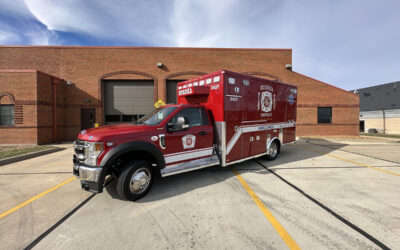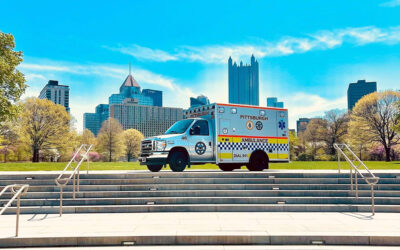
Photo by K.C. Wilsey/FEMA
By Jason D. Haag, CCEMT-P, CIC, CAC, CADS
As we move forward with available technology for prehospital care and for ambulance construction, it is important that we take these both into consideration when we are designing future vehicles. When you are considering priorities for your next vehicle, design priorities should be safety, functionality and value.
Safety. Let’s touch on that. Safety of both the crew and patient need to be priority. Typically, the patient is the best secured and safest person in the patient compartment of the ambulance. We have decades of tradition of not being restrained in the back of an ambulance when providing care which needs to stop. With the ability to have adjustable bucket seats in the patient care area and innovation with cabinet design and placement, this should be an issue easily fixed with engineering controls which will in turn, lead to a change in workplace practice. You may notice those two terms from bloodborne pathogen training. I use them here due to the same goal – mitigate risks to staff.
More from the Author
Let’s discuss functionality next. The way we’ve always built it isn’t helpful for ambulance design and use. Configuration of personnel seating, access, air handling, equipment storage and equipment mounting are all things you must take into consideration when designing your next ambulance. How close is frequently used/important equipment to your restrained crew members? Can the crew members remain restrained while being able to access the patient? Do you have proper filtration in your air handling? Is ingress and egress from the patient compartment practical and safe? Location of mounting equipment is something important to consider. Do you have to reach over the patient to stow patient movement equipment after the patient is loaded? Are all items secured with crash rated securing devices? One thing not often considered is any loose items in the back of an ambulance will become a projectile in a crash. Each item should have its own securing device or cabinet because of this.
Lastly is value. Notice I use the term value and not cost. We can easily purchase ambulances built the same way they always have been with a cost we have been used to. What we need to take into consideration is that these vehicles are not only a tool, but they are also an investment in our most important resources – our human resources. The extra cost we may incur in the design of ambulances will ultimately save us money in the long run. Forward thinking engineering will decrease workplace injuries and can significantly decrease the number of injuries in the unfortunate event of a collision. Ensuring safety of all in the patient compartment can also save money in litigation costs should there be a collision or another unfortunate event.
Our job, as EMS providers is simple – to be the best part of someone’s worse day. We do this with compassion, clinical care and our equipment. We should never sacrifice the safety our ourselves or our patients.
Jason D. Haag, CCEMT-P, CIC, CAC, CADS, is the quality assurance analyst and clinical educator for MultiMed Billing in Baldwinsville, NY. He is also an active paramedic with Wayne County Advanced Life Support, a firefighter for The City of Geneva Fire Department, and serves on many EMS boards and community organizations. Jason is also a speaker at many EMS conferences across the country.




